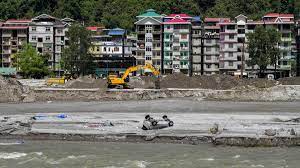
Causes of Flood in Sikkim
Causes of Flood in Sikkim
- Prelims: Chungthang Dam, Floods, Himalayan Ecosystem, National Disaster Management Authority, Early Warning System
- Main Exam: Glacier Lake Outburst Flood
October 09, 2023
Key points of Discussion
- What is Glacier Lake Outburst Flood (GLOF)?
- How do infrastructure projects like Chungthang Dam affect the Himalayan ecosystem?
- Can such incidents be predicted and prevented?
Why in News:
- Recently, serious impact of Glacial Lake Outburst Flood (GLOF) has been seen in the northeastern state of Sikkim in India.
What is a Glacial Lake Outburst:
- Technically a glacial lake outburst is called a Glacier Lake Outburst Flood (GLOF)
- Glacial lake outbursts, or jökulhlaups, are floods of very high intensity caused by the sudden withdrawal of water from a glacial lake.
- Glacial lakes can form either above, inside, below, or in front of glaciers and are inherently unstable.
- These are examples of large lakes formed by the melting of glaciers that are suddenly released from their moraines.
- Such eruptions have been responsible for many of the top floods in the world so far.
- South Lhonak Glacier in North Sikkim is reportedly one of the fastest melting glaciers.
- There are an estimated 7,500 glaciers in the Himalayas and GLOFs have been linked to major disasters over the years.
- Among the Himalayan states of India, Sikkim has more glaciers, about 80, than any other state. For years climatologists have warned that they could be responsible for the lake's eruption.
Causes of Sikkim GLOF:
- There is uncertainty among government agencies regarding this incident.
- According to satellite images of the National Remote Sensing Centre, Indian Space Research Organization, the main cause of this phenomenon is the change in the shape of the lake.
- According to DST-Wadia Institute of Himalayan Geology, since satellite images do not reveal the depth of the lake, it is challenging to calculate the volume of water in the lake without physically visiting the place.
- According to the report of water-monitoring equipment maintained by the Central Water Commission (CWC), the incident was caused by excessive rise in water level and heavy rain water flow in Sangklang.
- National Disaster Management has considered sudden excessive rainfall and GLOF phenomenon as the main cause of this incident.
- According to the National Disaster Management, the south lake is at an altitude of 5,200 meters and has a huge glacier to its north at a distance of about 6,800 meters.
- According to the India Meteorological Department (IMD), a series of earthquakes that hit Nepal on October 3, 2023 (the tremors of which left many people shaken in the Delhi National Capital Region) may have played a role.
Impact of flood:
- A glacial lake “South Lonak Lake” has been attributed to the uncontrolled floods in this state.
- South Lonak Lake is a glacial lake located at an altitude of 17,000 feet in the north-west of the state of Sikkim.
- Chungthang Dam has been damaged due to the impact of this flood. It is not a water storage dam, this dam supplies water for electricity generation to Teesta-3 Hydroelectric Project.
- Due to this flood, Chungthang hydro-dam (on Teesta river) in Sikkim also breached, affecting the overall situation.
- As a result, water was released into low-lying areas, causing flooding in the Teesta river, and the Sikkim State Disaster Management Authority (SSDMA) reports that four districts: Mangan, Gangtok, Pakyong and Namchi have been affected.
Are such events likely to occur in the future:
- According to the report of the National Disaster Management Agency, both the frequency and severity of such incidents may increase rapidly in future.
- Over the past few years, several studies have warned of the threat from GLOF events from the Himalayas.
- The Himalayan ecosystem is one of the most fragile in the world. Management of new resources in this Himalayan region can create unwanted serious problems for the people of this region.
- The construction and operation of hydroelectric projects and other dams over the past few decades have resulted in geological changes in the Himalayan ecosystem. The result of this change are GLOF events.
- There are an estimated 7,500 glaciers in the Himalayas and GLOFs have been linked to major disasters over the years.
- Climate change is increasing the frequency of these extreme events.
Examples of GLOF-related disasters:
- In 1926, flood in Jammu and Kashmir
- In 1981, flood of Kinnaur valley of Himachal Pradesh
- In June 2013, Uttarakhand witnessed massive flash floods due to the melting of the Chorabari Glacier (Kedarnath eruption), an event that caused intense bursting of the Mandakini River.
- In August 2014, there was a massive eruption in a glacial lake in Ladakh.
- In February 2021, the GLOF event was considered to be the main reason behind flash floods in Chamoli district of Uttarakhand.
- Explosion of glacier lake in Hunza Valley in Pakistan.
Way Forward:
- Unlike earthquakes, which occur relatively suddenly, GLOF events can be predicted and controlled in the following ways:
- Early warning systems should be implemented.
- A coordinated approach should be adopted for this, such that multiple trained agencies share satellite images immediately.
- A sensor network should be formed to provide adequate warning.
- Monitoring mechanism should be formed for highly sensitive areas because we can control events like floods by monitoring the changes in the size of lakes.
- As per National Disaster Management Authority guidelines, people should be made aware about the risks of GLOF.
- Additionally, there is a need to educate communities living in downstream areas about evacuation procedures and safety measures.
------------------------------------------
Mains Exam Question
- What is Glacial Lake Outburst Flood (GLOF)? How do infrastructure projects like Chungthang Dam affect the Himalayan ecosystem?
- Can such incidents be predicted and prevented?